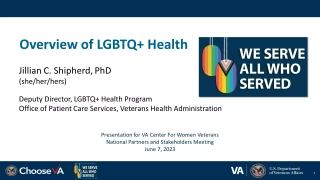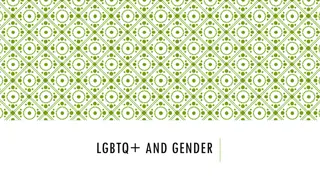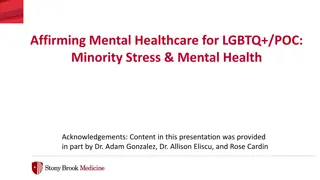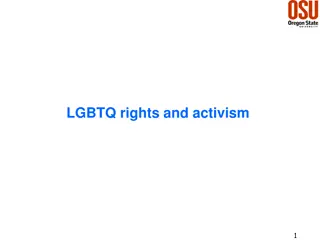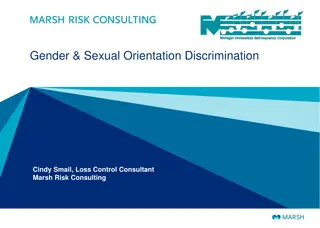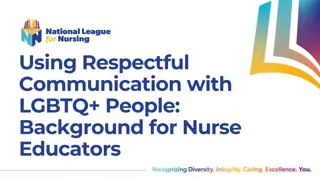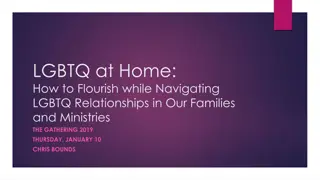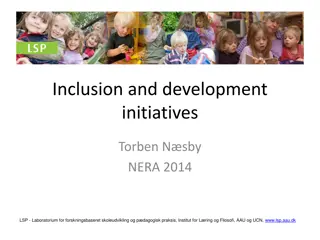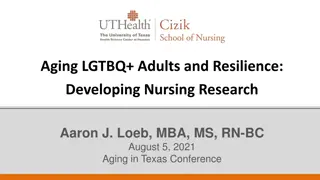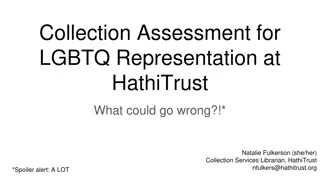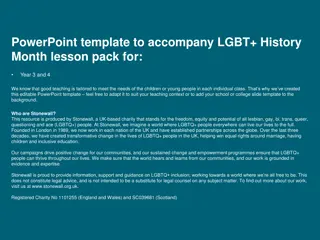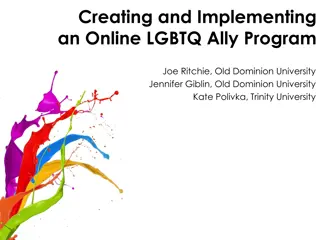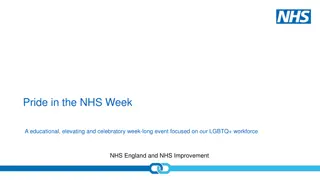Health and Care LGBTQ+ Inclusion Framework Briefing for Board Members
The Health and Care LGBTQ+ Inclusion Framework, developed by the NHS Confederation's Health and Care LGBTQ+ Leaders Network, aims to address the heightened risks faced by LGBTQ+ workforce members in the healthcare sector. It emphasizes creating inclusive cultures through visible leadership, staff support, knowledge enhancement, and tailored training. The framework's pillars focus on inclusivity and allyship, providing a roadmap for NHS organizations to promote equality, respect, and fair access to healthcare for all individuals.
Download Presentation

Please find below an Image/Link to download the presentation.
The content on the website is provided AS IS for your information and personal use only. It may not be sold, licensed, or shared on other websites without obtaining consent from the author.If you encounter any issues during the download, it is possible that the publisher has removed the file from their server.
You are allowed to download the files provided on this website for personal or commercial use, subject to the condition that they are used lawfully. All files are the property of their respective owners.
The content on the website is provided AS IS for your information and personal use only. It may not be sold, licensed, or shared on other websites without obtaining consent from the author.
E N D
Presentation Transcript
Insert trust logo Health and Care LGBTQ+ Inclusion Framework Briefing for board members The inclusion framework has been developed by the NHS Confederation's Health and Care LGBTQ+ Leaders Network, in conjunction with the Mental Health Network.
Introduction NHS Staff Survey data shows that the LGBTQ+ workforce remains at heightened risk of physical violence from patients, and bullying, harassment or abuse from colleagues. The NHS, along with other health and care organisations, needs to provide fair access to health and care for all, to improve the health of all parts of the population, and to be an inclusive employer. The Health and Care LGBTQ+ Inclusion Framework comprises six key pillars of inclusivity that NHS organisations should aim to achieve in order to create and maintain inclusive cultures.
Pillar 1 - We have visible leadership and confident staff Suggested actions: Share the lived experience of LGBTQ+ leaders through platforms such as webinars, blogs and staff-wide meetings. Ensure staff networks have an executive sponsor to support activities and feedback to your organisation s board. Make staff support, such as freedom to speak up guardians or staff networks, highly visible so colleagues know where to turn for help. Encourage non-LGBTQ+ leadership to visibly engage in organisational activities that support LGBTQ+ staff.
Pillar 1 - We have visible leadership and confident staff Our progress: Actions to date: Add details here 1.1 LGBTQ+ leaders are visible and can bring their whole selves to work. 1.2 LGBTQ+ staff network has been developed, is connected to decision- making and informs service delivery and training. 1.3 LGBTQ+ staff are supported when faced with conflict arising from their sexual orientation and gender identity. 1.4 Non-LGBTQ+ leaders model good allyship.
Pillar 2 - We have a strong knowledge base Suggested actions: Create an online learning hub for staff to access at a time that suits them. Include lived experience of LGBTQ+ patients and staff in your training materials or presentations. Deliver a mixed-media package of training to engage the widest range of staff. Work with your LGBTQ+ staff network and LGBTQ+ charities to create tailored training specific to your organisation and local population.
Pillar 2 - We have a strong knowledge base Our progress: Actions to date: Add details here 2.1 Staff understand the specific needs of LGBTQ+ people and the health inequalities they face. 2.2 A safe space has been created for staff to learn and ask questions. 2.3 Our organisation is learning and using appropriate language.
Pillar 3 - We are non-heteronormative and non-cisnormative in everything we do Suggested actions: Ensure equality impact assessments are being considered during the creation or review of policies and service development, not after. Take time to review policy documents, service literature and consent forms to ensure they are appropriate for gender non- conforming or trans service users. Make pronouns as visible as possible, encouraging staff to use them in email signatures and on name badges. Develop a positive and productive relationship with estate management. This is a helpful first step to creating inclusive spaces such as gender-neutral toilets.
Pillar 3 - We are non-heteronormative and non-cisnormative in everything we do Our progress: Actions to date: Add details here 3.1 Services are addressing the specific needs of LGBTQ+ people. 3.2 Gender identity and sexual orientation are not assumed, heterosexuality and cisgender are not considered the default.
Pillar 4 - We take responsibility for collecting and reporting data Suggested actions: Use training to build staff confidence to ask and share about being LGBTQ+ to collect better patient and workforce data. Use best practice learning from data collection of other protected characteristics. Take time to understand the quality of data needed to start making data-led decisions. Allow improving data collection and use to be an iterative process.
Pillar 4 - We take responsibility for collecting and reporting data Our progress: Actions to date: Add details here 4.1 Gender identity and sexual orientation information is being proactively sought from all staff and service users. 4.2 Staff are confident and competent in collecting data. 4.3 L, G, B, T, and Q data is reviewed separately and acted on accordingly.
Pillar 5 - We listen to our service users Suggested actions: Approach engagement with service users with an open mind there are numerous ways to engage meaningfully. Take time to develop meaningful relationships based on mutual trust. Consistently engage with your service users beyond the specific projects for which you are using their expertise.
Pillar 5 - We listen to our service users Our progress: Actions to date: Add details here 5.1 LGBTQ+ voices are included in co-production. 5.2 The needs of LGBTQ+ children and young people are being considered. 5.3 Action is being taken to create targeted interventions with the insight gathered.
Pillar 6 - We proactively seek out partners to co-deliver services Suggested actions: Consider partnership opportunities at the national, regional and local level. Invest time in building and maintaining trust with small community organisations. Use the integrated care system population health focus for engagement and co- development with partners outside the health service.
Pillar 6 - We proactively seek out partners to co-deliver services Our progress: Actions to date: Add details here 6.1 The knowledge and reach of third sector and community organisations are being used to design or commission services. 6.2 Lasting and meaningful relationships with local LGBTQ+ organisations are being fostered.
Next steps Next steps Include details on your proposed next steps.


